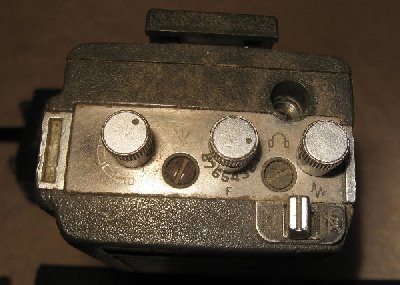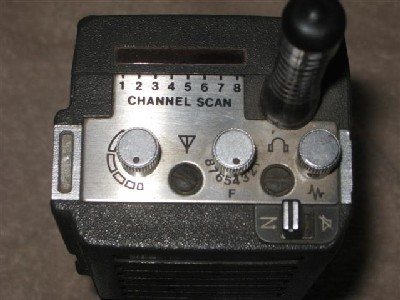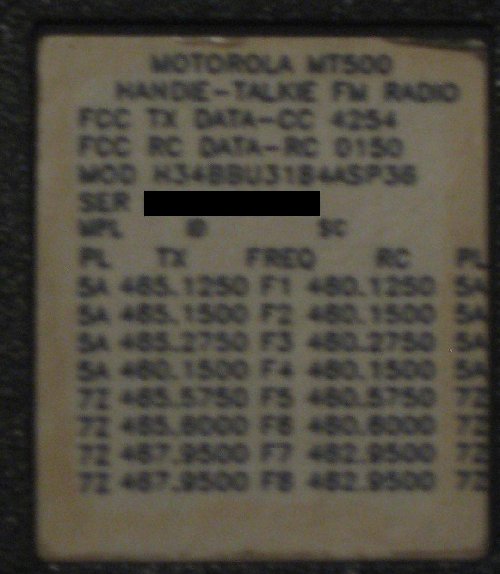Back to Home
compiled by Mike Morris WA6ILQ
Web page maintained by Robert Meister WA1MIK
I know nothing about this equipment so please don't ask!

|
Up one level (Main Moto page) Back to Home |
The Motorola MT500 / PT500 Series of Hand-held and Portable radios compiled by Mike Morris WA6ILQ Web page maintained by Robert Meister WA1MIK I know nothing about this equipment so please don't ask! |

|
 An eight frequency PL model. The PL/Carrier switch is in the lower right corner |
 An eight frequency PL and scan model. The Scan/PL/Carrier switch is in the lower right corner |
Does anyone have an original brochure or catalog sheet for the MT500 or the PT500?
The MT500 was the follow-on radio to the HT220 handheld, was first introduced in February of 1977 and used many of the existing accessories. The MT500 series was produced for only a few years before the MX series was introduced. The MX was the primary handheld radio during the period that saw the end of the crystal controlled radios and the introdution of the synthesized radios.
Like the HT220 the MT500 came in two versions - Slim-Line (sometimes called "Basic") and Omni (sometimes called "Universal"). The Omni / Universal models are thicker, allow larger (higher capacity) batteries and have a speaker-mic connector on the side, while the Slim-Line / Basic models has the jacks for speaker/earpiece and antenna on the (crowded) top of the radio. The additional thickness allows for a second layer of circuit board(s) for optional features - additional frequencies, higher power PAs, or even a multichannel scanner.
An additional difference is that the both the Basic and Universal radios came in two different heights of cases - short and tall cases. The additional 5/8 of an inch was used for smaller options like PL.
Since the PT500 is a MT500 in a "lunchbox" case with a big pack of "D" flashlight cells ora rechargeable battery (very popular with railroads, pipline crews, road crews, etc) those folks working on the PT500 radios will find the handheld manuals useful. Click here for an oblique view photo of an 8-channel PT500. Click here for a top view photo of an 8-channel PT500.
There used to be a web site at www.mt500.com that had a great deal of information on these radios but it went away in mid-2003. Also, there used to be a web page that gave information on the channel elements at http://users.leading.net/~radiotr/MT500 but it's gone also. If anyone knows who ran those web pages we'd be happy to talk to them about rehosting their information.
Like other Motorola radios of that era the MT500 RF section comes in multiple frequency
ranges or splits for each frequency band. Unfortunately the split is not encoded in the
model number.
For low band, the published splits are 30-36, 36-42 and 42-50 MHz. The manuals don't
mention a 25-30 MHz range but I've seen one on 26.62 MHz (a media remote pickup channel)
and several folks that I trust have told me that they were available in a 25-30 MHz
split.
Supposedly there were mid band MT500 radios for Europe. If so, they would probably be in
two splits, 66-77 and 77-88 MHz.
For high band there are three splits, 136-150.8, 150.8-162, and 162-174 MHz. I've seen
several MT500s on US Navy Shore Patrol channels in the 140-141 MHz.
For UHF there are four splits, 406-420, 450-470, 470-490, 490-512 MHz. There were
some SP radios on 512-524 MHz during the 1984 Olympics here in Los Angeles.
Where the prior models (the HT200 and HT220) used crystals the VHF and UHF models of this radio use small "Channel Element" in the receiver and transmitter, the low band MT500s continued to use crystals. A channel element is a plug-in module containing the crystal and a complete temperature compensated oscillator followed by a tripler-buffer. The multiplier chain following the channel element multipies up to what the exciter or receiver mixer needs. BTW, the transmit elements (either a KXN1083A or a KXN1042A) have five pins and the receive elements (KXN1075A) have only three pins. The crystals themselves are in a HC-49/X package.
Like all crystal controlled radios the MT500 radio is power miser, especially in receive. The average draw is about 11 milliamps squelched and 70 milliamps at a loud volume. In transmit the low power MT500 radios draw about 450 mills, and the high power radios draw just about an amp. Synthesized radios draw much, much more power. The 11 ma idle drain was a big selling point to the US Forest service for their firetower radios that ran on storage batteries.
 The serial tag on the back of the radio |
The MT500 Model Number:
Numbers that are in [brackets] refer to notes at the bottom of the tables.
| |||||||||||||||||||||||||
| |||||||||||||||||||||||||||||||||||||||||||
Notes:
[1]: There was no low power low band radio that I know of. The 41 series radio
produced 3 watts on a 12.7 volt Mercury battery or 6 watts on a 15 volt NiCD batery.
[2]: I've never seen a mid band (66-88 MHz) MT500 or the book for one.
[3]: I've been inside a 2-tone radio to change the reeds. It was a -2110CN and
the radio was not an SP radio.
[4]: This is the 1960s-1980s definition of narrowband. These days it's considered wideband.
[5]: I have no info on the translation of this column. I've seen radios with "0" and "4".
[6]: Think of this as the hardware version. You need a "C" radio or later to run DPL.
[7]: This column was dropped on some serial tags (like the one shown above).
[8]: a -SP suffix specifies that the radio was a Special Production (or Special Product,
or Special Purpose, take your pick...)... If a radio model number ends in SP followed by any number
or numbers then it was a special factory modification. It could be as simple as
a yellow or orange case for a railroad or it
could be a special IF frequency, or a special channel count or dual PL or... You would need the
exact manual (or manual supplement) to know what is going on with any but the most
obvious SP radio.
If the first letter of the model number was a "Z" then the radio was part of a special production
run, not a modification of a relatively small number of radios.
And some were shipped with "-SPnn" suffixes and some with "SPnn" (with out the "-") like shown above.
The MT500 Manual Library:
Thanks go to Brian Alesio, Skip Clark and Eric Lemmon for their contributions...
The "A" revision manual covers VHF (H23BBB, H33BBB, H23BBU, H33BBU) and UHF (H24BBB, H34BBB, H24BBU, H34BBU) units.
The low band radios (H31BBB and H31BBU) came out later and are included in the "B" revision of the manual. By the way, this manual pair is a good example of the later manual (the "B" revision) having less info on some topics that the earlier one (the "A" revision). If you are working on MT500s you will probably want to download both manual versions.
Where the prior models (the HT200 and HT220) used crystals the VHF and UHF models of this radio use small channel elements, the low band units use crystals. BTW, the transmit elements (either a KXN1083A or a KXN1042A) have five pins and receive elements (KXN1075A) have only three pins.
Since the PT500 is a MT500 in a "lunchbox" case with a big battery those folks working on the PT500 radios will find the handheld manuals useful.
| (no number) | Line drawing of an Omni radio 17 KB PDF donated by Eric Lemmon WB6FLY | ||||||||||||||||||||||||||||||||||||||||
| (no number) | Parts and Accessories list 1.91 MB PDF donated by Eric Lemmon WB6FLY | ||||||||||||||||||||||||||||||||||||||||
| 6881012C50-E | MT500 Series Operating Guide 628 KB PDF donated by Eric Lemmon WB6FLY | ||||||||||||||||||||||||||||||||||||||||
|
6881012C55-A 6881012C55-B |
HB and UHF MT500 Theory and Maintenance / Troubleshooting / Service Manual "A" version 6.13 MB, "B" version 3.7 MB both donated by Eric Lemmon WB6FLY The "A" version manual covers VHF (H23BBB, H33BBB, H23BBU, H33BBU) and UHF (H24BBB, H34BBB, H24BBU, H34BBU) units. The low band radios (H31BBB and H31BBU) came out later and are included in the "B" version manual. By the way, this manual pair is a good example of the later manual (the "B" revision) having less info on some topics that the earlier one (the "A" revision). If you are working on MT500s you will probably want to download both manual versions. |
||||||||||||||||||||||||||||||||||||||||
| 6881012C56-B | Supplement to 6881012C55, VHF 2 and 5W Service Manual 3.4 MB donated by Eric Lemmon WB6FLY | ||||||||||||||||||||||||||||||||||||||||
| 6881012C58-B | UHF 403-512 MHz (1.5 / 4 Watt) Service Manual 4.5 MB donated by Eric Lemmon WB6FLY | ||||||||||||||||||||||||||||||||||||||||
| 6881013C35-O | MT500 Convert-A-Com model N1248A Operating Instructions 145 KB PDF donated by Eric Lemmon WB6FLY | ||||||||||||||||||||||||||||||||||||||||
| 6881013C40-C | MT500 Convert-A-Com model N1248A Theory / Service Manual / Troubleshooting / Instruction Manual 4.6 MB donated by Eric Lemmon WB6FLY | ||||||||||||||||||||||||||||||||||||||||
| 6881013C45 | Timeout Timer Service Supplement (another list says "Time-Out Timer Option") | ||||||||||||||||||||||||||||||||||||||||
| 6881013C55 | Single Tone Service Supplement | ||||||||||||||||||||||||||||||||||||||||
| 6881013C60 | Selective Call Options Supplement (one list says Supplement, one says Manual) | ||||||||||||||||||||||||||||||||||||||||
| 6881014C45 | UHF 1 watt RF Output - Option H606AD | ||||||||||||||||||||||||||||||||||||||||
| 6881014C90 | Multiple Tone Private Line Options MT500 2,3,4,5 | ||||||||||||||||||||||||||||||||||||||||
| 6881016C15 | UHF 4 watt RF Output - Option H606AE | ||||||||||||||||||||||||||||||||||||||||
| 6881016C20 | UHF 1 watt RF Output - Crossband Operation - Option H610AA | ||||||||||||||||||||||||||||||||||||||||
| 6881016C25 | UHF 4 watt RF Output - Crossband Operation - Option H610AB | ||||||||||||||||||||||||||||||||||||||||
| 6881016C30 | UHF 1 watt RF Output - Option H611AA | ||||||||||||||||||||||||||||||||||||||||
| 6881016C85 | Unit ID, Emergency Call and Time-Out Timer ("TOT") Theory/Maint/Schematic | ||||||||||||||||||||||||||||||||||||||||
| 6881017C55-B | MT500 Low Band 30-50 MHz (6 W) Service Manual 3.8 MB donated by Eric Lemmon WB6FLY | ||||||||||||||||||||||||||||||||||||||||
| 6881018C40 | Digital "Private Line" Models | ||||||||||||||||||||||||||||||||||||||||
| 6881019C05 | Two Channel Scanner Option Supplement | ||||||||||||||||||||||||||||||||||||||||
| 6881019C70-D | Touch Code Option Supplement (AKA DTMF) 679 KB PDF donated by Eric Lemmon WB6FLY Covers options
|
||||||||||||||||||||||||||||||||||||||||
| 6881020C35 | Eight Channel Scanner Options Supplement (can be set for 3-8) | ||||||||||||||||||||||||||||||||||||||||
| 6881020C40 | DPL Service Supplement | ||||||||||||||||||||||||||||||||||||||||
| 6881020C80 | Z33BBU1152A Service Manual (another list says this manual part number is for "Five Channel Deck, Remote Microphone Connector" | ||||||||||||||||||||||||||||||||||||||||
| 6881020C85 | UHF RF Power Amplifier N1275A (35W) Service / Parts (this manual is still available
from Moto for about $14.00) This amplifier goes in line between the Convert-A-Com and the antenna. This same amplifier was used with the Convert-A-Com for the HT220 and also with the Mobile Vehicular Adapter (MVA) for the MT1000 handheld. Note that this amplifier is made in multiple "splits", just like the handheld or mobile radio. If you try and use an amplifier that is built for a split other than the radio that is feeding it (like 406-420 MHz amplifier on a 450-470 MHz radio) you will be sorry... |
||||||||||||||||||||||||||||||||||||||||
| 6881020C90 | VHF RF Power Amplifier N1274A (40W) Service / Parts This amplifier goes in line between the Convert-A-Com and the antenna. This same amplifier was used with the Convert-A-Com for the HT220 and also with the Mobile Vehicular Adapter (MVA) for the MT1000 handheld. The caution on the wrong split amplifier mentioned above on the UHF amplifier applies here as well. |
||||||||||||||||||||||||||||||||||||||||
| 6881024C70 | H34PTU Service Manual (IPTS) | ||||||||||||||||||||||||||||||||||||||||
| 6881024C80 | H33PTU Service Manual (IPTS) | ||||||||||||||||||||||||||||||||||||||||
| 6881024C95 | H33/H34PTU Operating Instructions (IPTS) | ||||||||||||||||||||||||||||||||||||||||
| 6881057C80 | MT500 Options Manual... Covers:
|
||||||||||||||||||||||||||||||||||||||||
| 6881102C04 | NSN6027A 12 Watt Amplified Speaker for MX3xx and MT500 series Converta-Com N1248A (866kB) Note that there were (are?) NSN6027A and NSN6027A-1 units. There are some differences - three capacitors are different values, one resistor was added, and better insulators were used on the power transistors. |
||||||||||||||||||||||||||||||||||||||||
| 6881102C29 | Single-Unit Battery Charger (standard rate - i.e. not a rapid charger) | ||||||||||||||||||||||||||||||||||||||||
| 6881102C45-D | Speaker-Microphone accessory model NMN6081A (straight cord), NMN6082A (coiled cord), NMN6089A (coiled cord with "quick disconnect" plug (for motorcycle, etc)) (121kB) | ||||||||||||||||||||||||||||||||||||||||
| 6881102C49 | External Speaker-Microphone and Antenna | ||||||||||||||||||||||||||||||||||||||||
| 6881102C55 | Single-Unit Rapid Battery Charger - Slim Models | ||||||||||||||||||||||||||||||||||||||||
| 6881102C69 | Surveillance Microphone and Earpiece | ||||||||||||||||||||||||||||||||||||||||
| 6881102C57 6881103C06 |
Multiple-Unit Rapid Battery Charger Both books have the same title - one is probably slimline the other omni, but the list said "Multiple-Unit Rapid Battery Charger" for both. |
||||||||||||||||||||||||||||||||||||||||
| 6881103C11-A | Single-Unit Rapid Battery Charger - Omni Models (349kB)
|
||||||||||||||||||||||||||||||||||||||||
| TT-402 | National Service Technicians Guide 1979 | ||||||||||||||||||||||||||||||||||||||||
| ? | Motorola National Service School Course "MT500 Handie Talkie Portables" | ||||||||||||||||||||||||||||||||||||||||
| ? | PT500 Advance Information
Digest 2.22 MB (a National Service Training Document dated August 1978) donated
by Eric Lemmon WB6FLY An interesting document, that, among other things, tells you how to modify a PT300 battery pack so you can use it on a PT500. |
||||||||||||||||||||||||||||||||||||||||
Unless otherwise noted all of the publications in the above list have been discontinued by Motorola.
Contact Information:
The author can be contacted at: his-callsign // at // repeater-builder // dot // com.
Back to the top of the page
Up one level (Main Moto page)
Back to Home
Artistic layout, text and hand-coded HTML © Copyright 2011 and date of last update by Mike Morris WA6ILQ
This page originally posted on Monday 30-Sept-2011
This web page, this web site, the information presented in and on its pages and in these modifications and conversions is © Copyrighted 1995 and (date of last update) by Kevin Custer W3KKC and multiple originating authors. All Rights Reserved, including that of paper and web publication elsewhere.